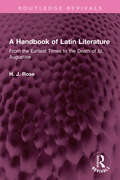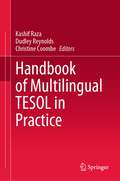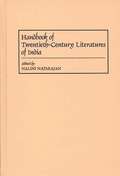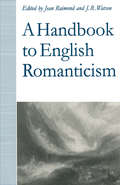- Table View
- List View
A Handbook of Latin Literature: From the Earliest Times to the Death of St. Augustine (Routledge Revivals)
by H. J. RoseFirst published in 1954, A Handbook of Latin Literature is an attempt to put together a cohesive account of classical and early post-classical writings in the Latin tongue, and is a companion to the Handbook of Greek Literature. The book traces the history of Latin literature from the earliest times down to the death of St. Augustine, and tackles both theological and non-theological interests of Christian authors. This book will be of interest to students of history and literature.
A Handbook of Middle English Studies (Critical Theory Handbooks)
by Marion TurnerA Handbook to Middle English Studies presents a series of original essays from leading literary scholars that explore the relationship between critical theory and late medieval literature. Includes 26 new essays by leading scholars of late medieval literature Sets the new standard for an introduction to the study of late medieval literature Showcases the most current cutting-edge theoretical research Demonstrates a range of approaches to late medieval literature Brings together critical theory and medieval literature
A Handbook of Middle English Studies (Critical Theory Handbooks)
by Marion TurnerA Handbook to Middle English Studies presents a series of original essays from leading literary scholars that explore the relationship between critical theory and late medieval literature. Includes 26 new essays by leading scholars of late medieval literature Sets the new standard for an introduction to the study of late medieval literature Showcases the most current cutting-edge theoretical research Demonstrates a range of approaches to late medieval literature Brings together critical theory and medieval literature
A Handbook of Modernism Studies (Critical Theory Handbooks #8)
by Jean-Michel RabatéFeaturing the latest research findings and exploring the fascinating interplay of modernist authors and intellectual luminaries, from Beckett and Kafka to Derrida and Adorno, this bold new collection of essays gives students a deeper grasp of key texts in modernist literature. Provides a wealth of fresh perspectives on canonical modernist texts, featuring the latest research data Adopts an original and creative thematic approach to the subject, with concepts such as race, law, gender, class, time, and ideology forming the structure of the collection Explores current and ongoing debates on the links between the aesthetics and praxis of authors and modernist theoreticians Reveals the profound ways in which modernist authors have influenced key thinkers, and vice versa
A Handbook of Modernism Studies (Critical Theory Handbooks #8)
by Jean-Michel RabatéFeaturing the latest research findings and exploring the fascinating interplay of modernist authors and intellectual luminaries, from Beckett and Kafka to Derrida and Adorno, this bold new collection of essays gives students a deeper grasp of key texts in modernist literature. Provides a wealth of fresh perspectives on canonical modernist texts, featuring the latest research data Adopts an original and creative thematic approach to the subject, with concepts such as race, law, gender, class, time, and ideology forming the structure of the collection Explores current and ongoing debates on the links between the aesthetics and praxis of authors and modernist theoreticians Reveals the profound ways in which modernist authors have influenced key thinkers, and vice versa
Handbook of Multilingual TESOL in Practice
by Christine Coombe Kashif Raza Dudley ReynoldsThis book presents exemplars of multilingualism in TESOL worldwide. It incorporates essential topics such as curriculum development, classroom instruction, materials creation, assessment, and teacher training where TESOL and multilingualism co-exist and co-develop. The wide-ranging and international collection of chapters is written by leading researchers in multilingualism and TESOL from around the world. This handbook provides unique insights into a range of practical approaches to promote local, indigenous and national languages in English language classrooms across a range of instructional programs in various geographical contexts. The book is divided into six sections. Part 1 presents curricular and principle-based approaches to multilingual TESOL in ESL/EFL classes. Part 2 includes chapters that showcase how diverse teachers bring multilingual TESOL to their classrooms. Part 3 discusses the challenges of teaching multilingual TESOL and how educators address them in their contexts. Part 4 provides activities and materials to support local languages in TESOL classrooms. Part 5 addresses assessment issues in multilingual TESOL. Part 6 includes initiatives and examples to prepare TESOL teachers to promote multilingualism in ESL/EFL classrooms.
Handbook of Native American Literature
by Andrew WigetThe Handbook of Native American Literature is a unique, comprehensive, and authoritative guide to the oral and written literatures of Native Americans. It lays the perfect foundation for understanding the works of Native American writers.Divided into three major sections, Native American Oral Literatures, The Historical Emergence of Native American Writing, and A Native American Renaissance: 1967 to the Present, it includes 22 lengthy essays, written by scholars of the Association for the Study of American Indian Literatures. The book features reports on the oral traditions of various tribes and topics such as the relation of the Bible, dreams, oratory, humor, autobiography, and federal land policies to Native American literature. Eight additional essays cover teaching Native American literature, new fiction, new theater, and other important topics, and there are bio-critical essays on more than 40 writers ranging from William Apes (who in the early 19th century denounced white society's treatment of his people) to contemporary poet Ray Young Bear.Packed with information that was once scattered and scarce, the Handbook of Native American Literature -a valuable one-volume resource-is sure to appeal to everyone interested in Native American history, culture, and literature. Previously published in cloth as The Dictionary of Native American Literature
Handbook of Native American Literature
by Andrew WigetThe Handbook of Native American Literature is a unique, comprehensive, and authoritative guide to the oral and written literatures of Native Americans. It lays the perfect foundation for understanding the works of Native American writers.Divided into three major sections, Native American Oral Literatures, The Historical Emergence of Native American Writing, and A Native American Renaissance: 1967 to the Present, it includes 22 lengthy essays, written by scholars of the Association for the Study of American Indian Literatures. The book features reports on the oral traditions of various tribes and topics such as the relation of the Bible, dreams, oratory, humor, autobiography, and federal land policies to Native American literature. Eight additional essays cover teaching Native American literature, new fiction, new theater, and other important topics, and there are bio-critical essays on more than 40 writers ranging from William Apes (who in the early 19th century denounced white society's treatment of his people) to contemporary poet Ray Young Bear.Packed with information that was once scattered and scarce, the Handbook of Native American Literature -a valuable one-volume resource-is sure to appeal to everyone interested in Native American history, culture, and literature. Previously published in cloth as The Dictionary of Native American Literature
Handbook of Norse Mythology (World Mythology)
by John LindowAuthoritative, comprehensive reference incorporating the latest research on tales, literary and oral sources, and the broad-reaching cultural legacy of Norse mythology.The book describes the pagan origins of Scandinavia, the interaction between the Vikings and other Europeans, and the concept of time in Norse mythology, and gives a dictionary of deities, themes, and concepts. With 200 entries of up to four pages each, the dictionary includes both well-known characters like Thor and minor figures such as Gleipnir, the "fetter with which the wolf Fenrir was finally bound." It also includes further references about Viking and medieval Scandinavia, archaeology, etymology, the conversion of Iceland, other encyclopedias, and more.
A Handbook of Romanticism Studies (Critical Theory Handbooks #6)
by Joel Faflak Julia M. WrightThe Handbook to Romanticism Studies is an accessible and indispensible resource providing students and scholars with a rich array of historical and up-to-date critical and theoretical contexts for the study of Romanticism. Focuses on British Romanticism while also addressing continental and transatlantic Romanticism and earlier periods Utilizes keywords such as imagination, sublime, poetics, philosophy, race, historiography, and visual culture as points of access to the study of Romanticism and the theoretical concerns and the culture of the period Explores topics central to Romanticism studies and the critical trends of the last thirty years
A Handbook of Romanticism Studies (Critical Theory Handbooks #5)
by Joel Faflak Julia M. WrightThe Handbook to Romanticism Studies is an accessible and indispensible resource providing students and scholars with a rich array of historical and up-to-date critical and theoretical contexts for the study of Romanticism. Focuses on British Romanticism while also addressing continental and transatlantic Romanticism and earlier periods Utilizes keywords such as imagination, sublime, poetics, philosophy, race, historiography, and visual culture as points of access to the study of Romanticism and the theoretical concerns and the culture of the period Explores topics central to Romanticism studies and the critical trends of the last thirty years
The Handbook of the Gothic
by Marie Mulvey-RobertsThis revised new edition of The Handbook of the Gothic contains over one hundred entries on Gothic writers, themes, terms, concepts, contexts and locations, featuring new entries on writers including Stephen King and Wilkie Collins, new genres and a new Preface which situates the handbook within current studies of the Gothic.
Handbook of Twentieth-Century Literatures of India
by Nalini NatarajanIndia has a rich literary assemblage produced by its many different regional traditions, religious faiths, ethnic subcultures and linguistic groups. The published literature of the 20th century is a particularly interesting subject and is the focus of this book, as it represents the provocative conjuncture of the transitions of Indian modernity. This reference book surveys the major regional literatures of contemporary India in the context of the country's diversity and heterogeneity. Chapters are devoted to particular regions, and the arrangement of the work invites comparisons of literary traditions. Chapters provide extensive bibliographies of primary works, thus documenting the creative achievement of numerous contemporary Indian authors. Some chapters cite secondary works as well, and the volume concludes with a list of general works providing further information.An introductory essay overviews theoretical concerns, ideological and aesthetic considerations, developments in various genres, and the history of publishing in regional literatures. The introduction provides a context for approaching the chapters that follow, each of which is devoted to the literature of a particular region. Each chapter begins with a concise introductory section. The body of each chapter is structured according to social and historical events, literary forms, or broad descriptive or analytic trends, depending on the particular subject matter. Each chapter then closes with an extensive bibliography of primary works, thus documenting the rich literary tradition of the region. Some chapters also cite secondary sources as an aid to the reader. The final chapters of the book address special topics, such as sub-cultural literatures, or the interplay between literature and film. A list of additional sources of general information concludes the volume.
A Handbook to Classical Reception in Eastern and Central Europe (Wiley Blackwell Handbooks to Classical Reception)
by Zara Martirosova Torlone Dana LaCourse Munteanu Dorota DutschA Handbook to Classical Reception in Eastern and Central Europe is the first comprehensive English9;]language study of the reception of classical antiquity in Eastern and Central Europe. This groundbreaking work offers detailed case studies of thirteen countries that are fully contextualized historically, locally, and regionally. The first English-language collection of research and scholarship on Greco-Roman heritage in Eastern and Central Europe Written and edited by an international group of seasoned and up-and-coming scholars with vast subject-matter experience and expertise Essays from leading scholars in the field provide broad insight into the reception of the classical world within specific cultural and geographical areas Discusses the reception of many aspects of Greco-Roman heritage, such as prose/philosophy, poetry, material culture Offers broad and significant insights into the complicated engagement many countries of Eastern and Central Europe have had and continue to have with Greco-Roman antiquity
A Handbook to Classical Reception in Eastern and Central Europe (Wiley Blackwell Handbooks to Classical Reception)
by Zara Martirosova Torlone Dana LaCourse Munteanu Dorota DutschA Handbook to Classical Reception in Eastern and Central Europe is the first comprehensive English9;]language study of the reception of classical antiquity in Eastern and Central Europe. This groundbreaking work offers detailed case studies of thirteen countries that are fully contextualized historically, locally, and regionally. The first English-language collection of research and scholarship on Greco-Roman heritage in Eastern and Central Europe Written and edited by an international group of seasoned and up-and-coming scholars with vast subject-matter experience and expertise Essays from leading scholars in the field provide broad insight into the reception of the classical world within specific cultural and geographical areas Discusses the reception of many aspects of Greco-Roman heritage, such as prose/philosophy, poetry, material culture Offers broad and significant insights into the complicated engagement many countries of Eastern and Central Europe have had and continue to have with Greco-Roman antiquity
The Handbook to Gothic Literature
by Marie Mulvey-RobertsWhat do we mean by the term 'Gothic'? How does it differ from such classifications as 'terror' and 'horror' and where do its parameters lie? In an attempt to define such an elusive term, this A-Z unearths the terminologies associated with Gothic through a variety of short essays written by leading scholars. Not only does it plot the national characteristics of Gothic as in the French school of terror, Frenetique to American Gothic, but it also spans the period from Ann Radcliffe to Anne Rice.
The Handbook to Literary Research
by Delia Da Sousa Correa W. R. OwensThe Handbook to Literary Research is a practical guide for students embarking on postgraduate work in Literary Studies. It introduces and explains research techniques, methodologies and approaches to information resources, paying careful attention to the differences between countries and institutions, and providing a range of key examples. This fully updated second edition is divided into five sections which cover: tools of the trade – a brand new chapter outlining how to make the most of literary resources textual scholarship and book history – explains key concepts and variations in editing, publishing and bibliography issues and approaches in literary research – presents a critical overview of theoretical approaches essential to literary studies the dissertation – demonstrates how to approach, plan and write this important research exercise glossary – provides comprehensive explanations of key terms, and a checklist of resources. Packed with useful tips and exercises and written by scholars with extensive experience as teachers and researchers in the field, this volume is the ideal Handbook for those beginning postgraduate research in literature.
The Handbook to Literary Research
by Delia da Sousa Correa W. R. OwensThe Handbook to Literary Research is a practical guide for students embarking on postgraduate work in Literary Studies. It introduces and explains research techniques, methodologies and approaches to information resources, paying careful attention to the differences between countries and institutions, and providing a range of key examples. This fully updated second edition is divided into five sections which cover: tools of the trade – a brand new chapter outlining how to make the most of literary resources textual scholarship and book history – explains key concepts and variations in editing, publishing and bibliography issues and approaches in literary research – presents a critical overview of theoretical approaches essential to literary studies the dissertation – demonstrates how to approach, plan and write this important research exercise glossary – provides comprehensive explanations of key terms, and a checklist of resources. Packed with useful tips and exercises and written by scholars with extensive experience as teachers and researchers in the field, this volume is the ideal Handbook for those beginning postgraduate research in literature.
A Handbook to Sixteenth-Century Rhetoric (Routledge Revivals)
by Lee A. SonninoFirst published in 1968, A Handbook to Sixteenth-Century Rhetoric is designed primarily to assist the student of renaissance literature in the science of rhetoric. It gathers together the information provided by the various different authorities who contributed to the education of the renaissance author, particularly the writer in English. These authorities include key classical rhetoricians he would probably have read, well-known and important renaissance rhetoricians, and the writers of vernacular treatises and of major school textbooks. The information is arranged in a schematic and tabular form, so that enquiry can start from the object, the particular rhetorical form as it appears in a given literary text. The core of the book is the central section on elocutio, the art of using the devices of rhetorical ornament.
A Handbook to Sixteenth-Century Rhetoric (Routledge Revivals)
by Lee A. SonninoFirst published in 1968, A Handbook to Sixteenth-Century Rhetoric is designed primarily to assist the student of renaissance literature in the science of rhetoric. It gathers together the information provided by the various different authorities who contributed to the education of the renaissance author, particularly the writer in English. These authorities include key classical rhetoricians he would probably have read, well-known and important renaissance rhetoricians, and the writers of vernacular treatises and of major school textbooks. The information is arranged in a schematic and tabular form, so that enquiry can start from the object, the particular rhetorical form as it appears in a given literary text. The core of the book is the central section on elocutio, the art of using the devices of rhetorical ornament.
The Handbook to the Bloomsbury Group
by Derek Ryan Stephen RossThe Handbook to the Bloomsbury Group is the most comprehensive available survey of contemporary scholarship on the Bloomsbury Group – the set of influential writers, artists and thinkers whose members included Virginia Woolf, Leonard Woolf, E.M. Forster, John Maynard Keynes, Vanessa Bell, Clive Bell, Duncan Grant and David Garnett. With chapters written by world leading scholars in the field, the book explores novel avenues of thinking about these pivotal figures and their works opened up by the new modernist studies. It brings together overview essays with detailed illustrative case studies, and covers topics as diverse as feminism, sexuality, empire, philosophy, class, nature and the arts. Setting the agenda for future study of Bloomsbury, this is an essential resource for scholars of 20th-century modernist culture.
The Handbook to the Bloomsbury Group
by Derek Ryan Stephen RossThe Handbook to the Bloomsbury Group is the most comprehensive available survey of contemporary scholarship on the Bloomsbury Group – the set of influential writers, artists and thinkers whose members included Virginia Woolf, Leonard Woolf, E.M. Forster, John Maynard Keynes, Vanessa Bell, Clive Bell, Duncan Grant and David Garnett. With chapters written by world leading scholars in the field, the book explores novel avenues of thinking about these pivotal figures and their works opened up by the new modernist studies. It brings together overview essays with detailed illustrative case studies, and covers topics as diverse as feminism, sexuality, empire, philosophy, class, nature and the arts. Setting the agenda for future study of Bloomsbury, this is an essential resource for scholars of 20th-century modernist culture.
A Handbook to the Reception of Classical Mythology (Wiley Blackwell Handbooks to Classical Reception)
by Vanda Zajko Helena HoyleA Handbook to the Reception of Classical Mythology presents a collection of essays that explore a wide variety of aspects of Greek and Roman myths and their critical reception from antiquity to the present day. Reveals the importance of mythography to the survival, dissemination, and popularization of classical myth from the ancient world to the present day Features chronologically organized essays that address different sets of myths that were important in each historical era, along with their thematic relevance Features chronologically organized essays that address different sets of myths that were important in each historical era, along with their thematic relevance Offers a series of carefully selected in-depth readings, including both popular and less well-known examples
A Handbook to the Reception of Classical Mythology (Wiley Blackwell Handbooks to Classical Reception)
by Vanda Zajko Helena HoyleA Handbook to the Reception of Classical Mythology presents a collection of essays that explore a wide variety of aspects of Greek and Roman myths and their critical reception from antiquity to the present day. Reveals the importance of mythography to the survival, dissemination, and popularization of classical myth from the ancient world to the present day Features chronologically organized essays that address different sets of myths that were important in each historical era, along with their thematic relevance Features chronologically organized essays that address different sets of myths that were important in each historical era, along with their thematic relevance Offers a series of carefully selected in-depth readings, including both popular and less well-known examples
















